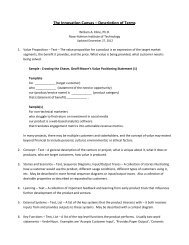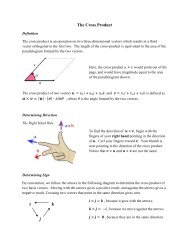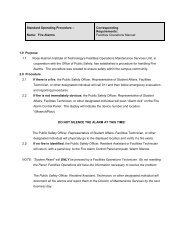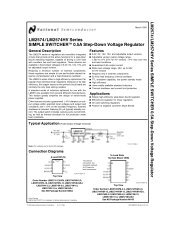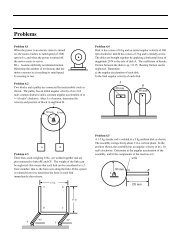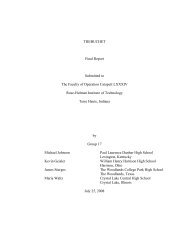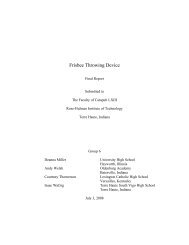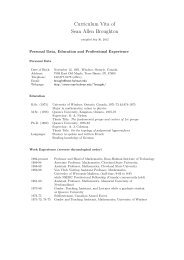21 Photosynthesis (Carbon Assimilation) The light ... - Rose-Hulman
21 Photosynthesis (Carbon Assimilation) The light ... - Rose-Hulman
21 Photosynthesis (Carbon Assimilation) The light ... - Rose-Hulman
You also want an ePaper? Increase the reach of your titles
YUMPU automatically turns print PDFs into web optimized ePapers that Google loves.
<strong>The</strong> phosphoglycolate produced must be converted to 3-phosphoglycerate by the<br />
photorespiration pathway. <strong>The</strong> process is called photorespiration because it results<br />
in oxygen consumption and carbon dioxide production; in effect it uses energy to run<br />
the rubisco reaction in reverse. Photorespiration uses several different<br />
compartments, and requires glycine as a pseudo-coenzyme (the glycine carbon<br />
effectively comes from phosphoglycolate, but the amino group nitrogen is lost). In<br />
the overall process, two molecules of phosphoglycolate are converted to one molecule<br />
of 3-phosphoglycerate, with loss of nitrogen as ammonia, loss of carbon dioxide, and<br />
the utilization of a molecule of ATP<br />
O<br />
H<br />
H<br />
O<br />
H 2 C<br />
C<br />
C<br />
C<br />
H 2 C<br />
O<br />
O<br />
P<br />
O<br />
OH<br />
OH<br />
O<br />
P<br />
O<br />
O<br />
O<br />
Ribulose<br />
1,5-bisphosphate<br />
O 2<br />
Hydroxypyruvate<br />
Ribulose-<br />
1,5-bisphosphate<br />
carboxylase<br />
oxygenase<br />
Calvin<br />
cycle<br />
H<br />
O<br />
H 2 C<br />
C<br />
O<br />
O<br />
P<br />
O<br />
O<br />
O<br />
Phosphoglycolate<br />
O<br />
C<br />
C<br />
H 2 C<br />
O<br />
O<br />
OH<br />
O<br />
P<br />
O<br />
O<br />
ADP<br />
3-Phosphoglycerate<br />
Chloroplast<br />
Phosphoglycolate<br />
phosphatase<br />
ATP<br />
Glycerate<br />
kinase<br />
H<br />
H 2 C<br />
C<br />
O<br />
OH<br />
O<br />
Glycolate<br />
O<br />
C<br />
C<br />
H 2 C<br />
O<br />
OH<br />
OH<br />
Glycerate<br />
H<br />
H 2 C<br />
C<br />
O<br />
OH<br />
O<br />
Glycolate<br />
O<br />
C<br />
C<br />
H 2 C<br />
O<br />
OH<br />
OH<br />
Glycerate<br />
O 2 H 2 O 2<br />
Glycolate<br />
oxidase<br />
NAD<br />
NADH<br />
-Hydroxyacid<br />
reductase<br />
Peroxisome<br />
HC O<br />
C O<br />
O<br />
Glyoxalate<br />
H 2 C<br />
HO<br />
O<br />
C<br />
C<br />
O<br />
O<br />
Serine<br />
aminotransferase<br />
H 2 C<br />
HO<br />
NH 3<br />
CH 2<br />
CH 2<br />
C O<br />
O<br />
Glycine<br />
NH 3<br />
CH<br />
C<br />
O<br />
O<br />
Serine<br />
NH 3 NH 3<br />
CH 2<br />
C<br />
O<br />
O<br />
Glycine<br />
NAD<br />
NADH<br />
+ NH 3<br />
+ CO 2<br />
Mitochondrion<br />
H 2 C<br />
HO<br />
+<br />
C<br />
O<br />
O<br />
Glycine<br />
Glycine<br />
decarboxylase<br />
NH 3<br />
CH<br />
C<br />
O<br />
O<br />
Serine<br />
<br />
<br />
<br />
<br />
<br />
Photorespiration is a remarkably wasteful process; both conversion of<br />
phosphoglycolate to 3-phosphoglycerate and regeneration of ribulose-1,5-phosphate<br />
require ATP. <strong>The</strong> energy lost in this process has been estimated to decrease plant<br />
growth by as much as 50%.<br />
<strong>The</strong> purpose of the oxygenase activity of rubisco is not known. However, no<br />
organisms have evolved a rubisco that lacks this oxygenase activity. It is possible<br />
that the oxygenase may act as protection from damaging photooxidation; <strong>light</strong> in<br />
absence of CO 2 appears to result in photooxidation damage to the cell.<br />
Alternatively, the limited specificity of the enzyme may be a vestige of the historical<br />
time period when free oxygen was rare.<br />
<strong>The</strong> mechanistic reason for the oxygenase activity is clear. <strong>The</strong> rubisco K m for CO 2<br />
is ~9 µM, a value that increases with temperature. <strong>The</strong> rubisco K m for O 2 is ~350<br />
µM. Atmospheric partial pressures of oxygen and carbon dioxide result in dissolved<br />
concentrations in water for carbon dioxide of ~11 µM and for oxygen of ~250 µM.<br />
Under normal conditions, the ratio of carbon dioxide to oxygen utilization is roughly<br />
3 to 1. At higher temperatures, the K m for carbon dioxide rises, and the result is<br />
Copyright © 2010-2011 by Mark Brandt, Ph.D.<br />
32





